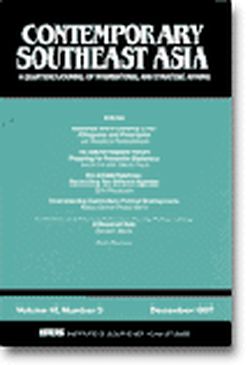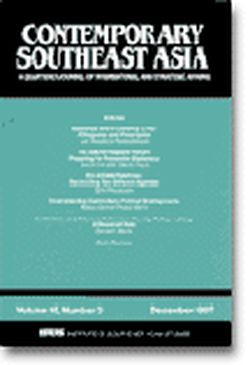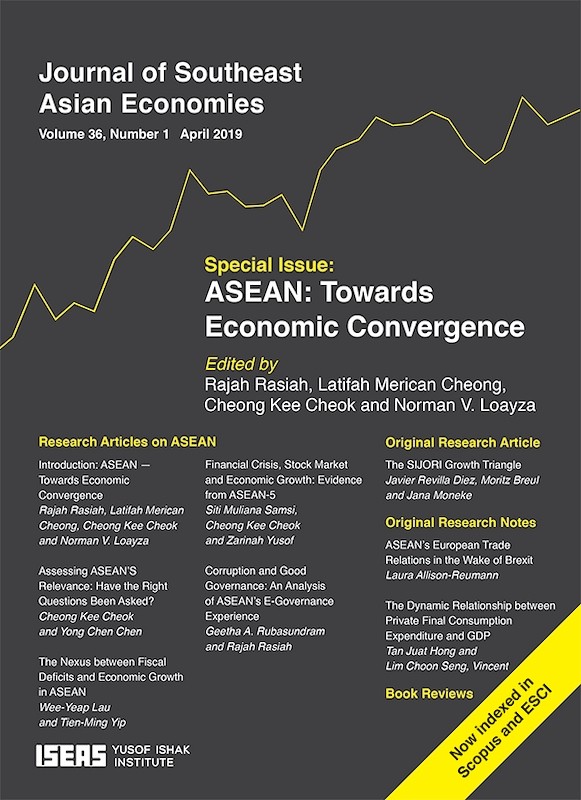Contemporary Southeast Asia: A Journal of International and Strategic Affairs Vol. 13/3(Dec 1991)

Date of publication:
December 1991
Number of pages:
100
Code:
CS13/3
Contents
-
Preliminary pages
- ARTICLES
-
Thailand and the Dynamics of Economic and Security Complex in Mainland Southeast Asia, by Khatharya Um, author see abstractIn recent years, the decline of Vietnam's position in Indochina, as well as China's improved relations with the ASEAN countries, have encouraged Thailand to embark on schemes for transforming itself into the economic centre of a resurgent mainland Southeast Asia. Thailand's current economic power and exigencies of moving to the next stage of industrialization complement the emergent desire of its underdeveloped neighbours for rapid progress through economic modernization. Although economic imperatives have become a central determinant of Thailand's foreign policy, external economic objectives are also linked to its longer term security goals.
-
Ending an Armed Struggle Without Surrender: The Demise of the Communist Party of Malaya (1979-89) and the Aftermath, by Leonard C Sebastian, author see abstractThe dramatic changes in the communist world have had a profound effect on domestic communist movements in Southeast Asia. The formal conclusion of the four decade-long communist insurgency in Malaysia is not only an implicit reflection of these realities, but more importantly, it indicates that developing countries con combat such insurgencies through the effective use of diplomacy, military strategy and rural development policies. The ex-communists and their intrepid leader, Chin Peng, have vowed to carry on their political struggle through legal channels. With their possible return to open politics in the near future, Malaysia is on the threshold of a new era in its political evolution. The article focuses on the lost ten years of the waning communist insurgency. It probes and analyses the significant events of this period that led to the demise of the Communist Party of Malaya and raises questions regarding its future role in Malaysian politics.
-
The ASEAN Growth Triangle: The Convergence of National and Sub-National Interests, by Pushpa Thambipillai, author see abstractWhile ASEAN promotes economic co-opercition through intraand extra-regional activities, a recent sub-regional initiative has attracted much attention. The Growth Triangle concept, the first case linking Singapore with its neighbours, Johor and Riau, has shown that with governmental support, the public and private sectors in the participating sub-regions can co-operate in certain mutually beneficial sectors. However, this con only be accomplished with the full support of the national political leaders, which is particularly significant in the Riau and Johor cases where state (provincial) leaders come under central authority. National leaders will support such sub-national external collaboration if they see tangible benefits to the participating state and country and do not fear any competition or challenge to their national roles and decision-making authority.
-
ASEAN: Where from or where to?, by Mark G Rolls, author see abstractIt is now widely recognized that the Association of Southeast Asian Nations (ASEAN) has reached, in respect of all its spheres of activity, a watershed. A number off actors influencing its previous pattern of development have changed as con be seen in the set of regional and international circumstances which ASEAN now faces. At the some time, there are already some indicators as to the direction the Association may take in the future. The books under review here successfully provide the basis on which an analysis of these two aspects con be made. This article, therefore, traces the development of ASEAN co-opercition in the political, economic, and security spheres, and attempts to consider how the aforementioned changes are likely to affect this co-operation and what shape it may take in the future. It reaches the conclusion that the forthcoming Singapore summit will need to set clear directions for ASEAN co-operation if the Association is to progress further and avoid becoming circumspect and outdated.
- BOOK REVIEWS
-
BOOK REVIEW: Unity and Diversity: Regional Economic Development in Indonesia Since 1970 edited by Hal Hill, by Khong Cho Oon , author
-
BOOK REVIEW: Truth and Power: Robert S Hardie and Land Reform Debates in the Philippines, 1950-1987 by Paul M Monk, by Elpidio Sta. Romana, author
-
BOOK REVIEW: The Kuomintang Movement in British Malaya 1912-1949 by C F Yong and R B Mc Kenna, by Manivannan, author
-
BOOK REVIEW: Grand Strategies in War and Peace edited by Paul Kennedy, by William A Comley, author






